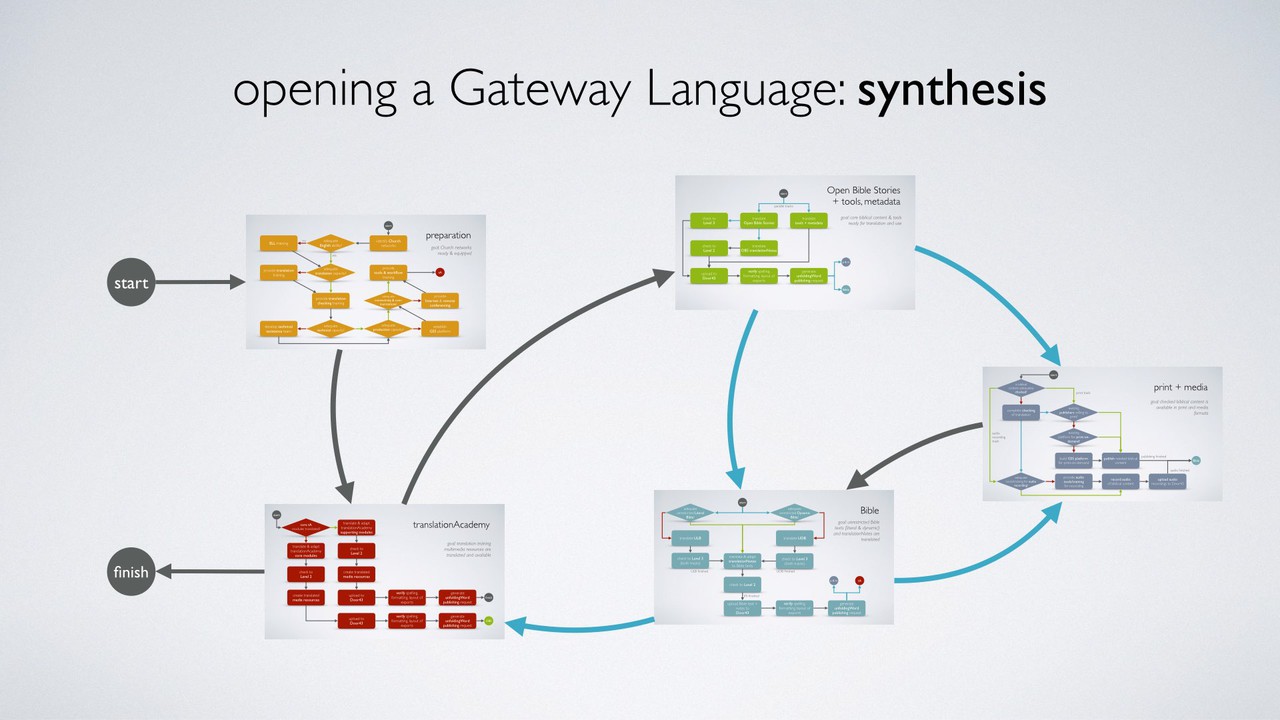A procedural overview for how to make content, tools, and training available in each gateway language.
Contents:
- About this document
- Preparation
- translationAcademy
- Open Bible Stories + tools, metadata
- Bible
- Print + Media
Download PDF
Current document revision: 10
About this document
This document describes the process required to “open” a Gateway Language. This document assumes a working knowledge of the Gateway Language Strategy as well as our multi-tiered approach to checking of translated biblical content. The basic structure of this document is first to address the overview of the process, then describe the flowcharts for each aspect of the process, then synthesize all of the component pieces at the end.
This document is the result of input from many people and countless hours of research, development, trial and error, and testing of new tools and strategies. It should be considered a work in progress, and the current version will always be available online.
The Flow of Content through a Gateway Language
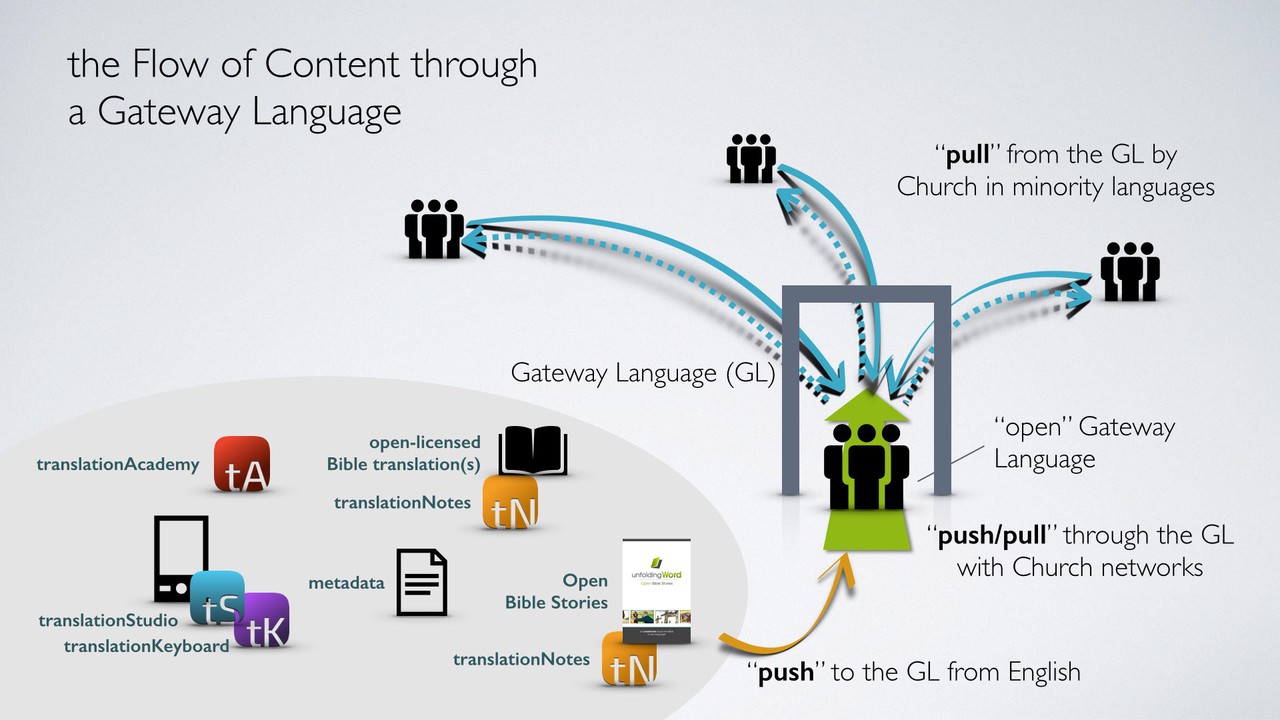
This illustrates how the various pieces of content (including sources, explanatory resources, and tools/metadata for apps and printing) flow from English to each Gateway Language (GL). The unfoldingWord network is “pushing” the content outward to each GL, where a team comprised of various Church networks receives (“pulls”) the content from English into the GL where it can be “pulled” by the Church in people groups behind the GLs into any/all minority languages.
Note that this procedural overview should not be confused with the process for translation from the GLs into the minority languages behind them. That process is significantly different and is beyond the scope of what is addressed here.
Conceptual Overview
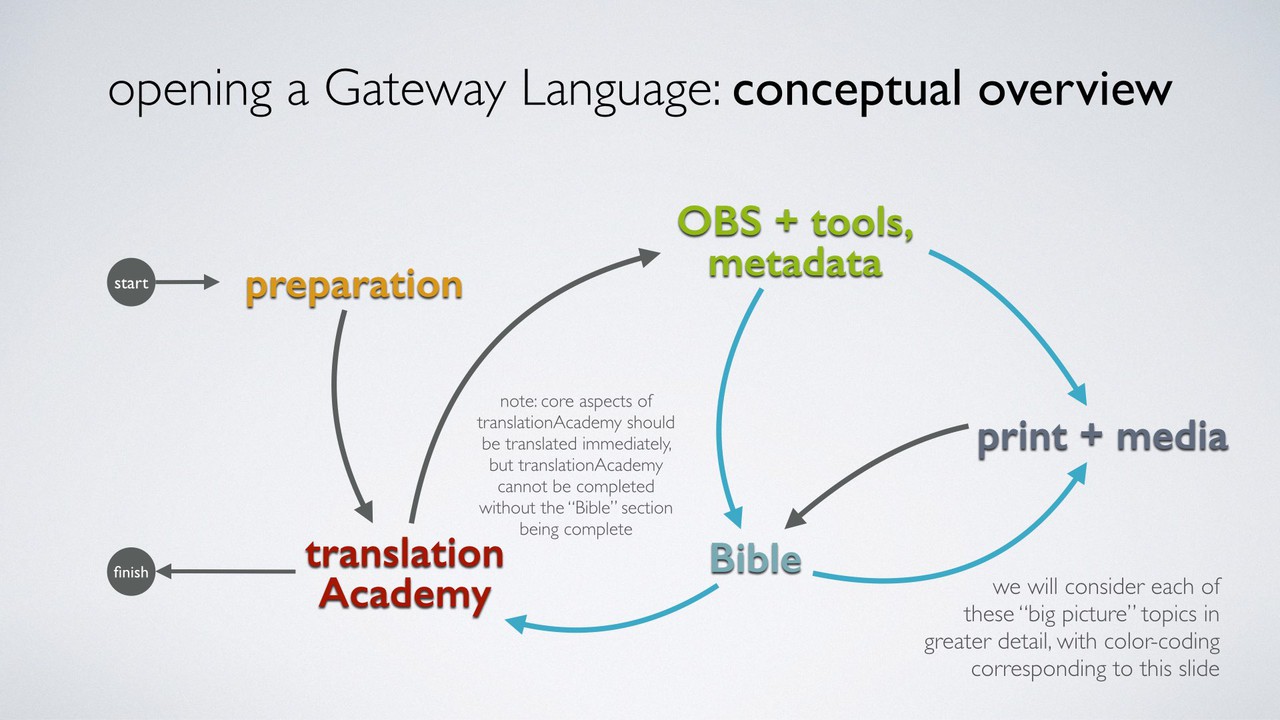
There are five core aspects of opening a Gateway Language, each of which is addressed in greater detail below:
- Preparation — before translation of content can happen, the translators must be identified, equipped, trained, and aligned.
- translationAcademy — once a team has been established, core elements of the translationAcademy pertaining to principles and procedures of translation and checking of translated biblical content are translated.
- Open Bible Stories + tools, metadata — next, the Open Bible Stories text and translationNotes are translated into the GL, together with the essential metadata and text for the translation software tools.
- Bible — the Bible source texts, exegetical resources and translation helps are translated.
- Print + Media — production capacity for printing and recording of biblical content in audio (and other media) formats is provided.
Preparation

The first step is to identify the Church networks that agree with our Statement of Faith, Translation Guidelines, use of an Open License, and our strategy. Eventually, we will need three networks, in order to clear the Level 3 checking requirement. Note that all contributors need to sign a license releasing all their contributions under CC BY-SA 4.0. At least the human-readable license will need to be translated into the Gateway Language at this point, and the whole license will be needed eventually.
These Church networks need to have translators who have adequate command of English as a second language. If not, consider using an ELL training program to improve their English capacity, as almost all source content (except for potential open-licensed/public domain Bible translations in the GL) is in English.
Next, they need to have adequate translation capacity (or it needs to be provided). The checkers need to be trained in our checking process and level system. This is explained in detail in the (forthcoming) Checking Manual, part of translationAcademy.
The translators need adequate technical capacity to use the various technology tools (or they need a technical assistance team that can be so trained). They need adequate production capacity, in terms of available people, time, and financial resources. If not, like-minded businesses may be able to help establish a platform to increase their capacity.
They need adequate Internet connectivity and ability to use various communication tools (e.g. Slack, video conferencing, web-based project management software, etc.). Like-minded technology ministries may be able to help provide connectivity solutions if none are readily available.
Finally, a tactical workflow must be developed and the team trained in how to use the tools in it to accomplish the desired outcomes in the most efficient manner possible.
translationAcademy

The translationAcademy is in active development and is comprised of three primary sections: Translation Manual, Checking Manual, and Technology Manual. Each of these sections contain “core modules” that together comprise the “translationAcademy Handbook”. In the first pass through the translation of translationAcademy modules, all the modules in this guide should be translated and checked to at least Level 2.
Voice assets in the GL should be identified and the training resources recorded as audio files, for use by primarily oral translators. Note: depending on the context, it may be necessary to jump to the “audio track” of the “printing + media” section.
All content, text and audio, needs to be uploaded to the Door43 server where the translators should verify that spelling, formatting, layout, etc. are all correct. Once it’s ready to go, they should generate an unfoldingWord publishing request (http://ufw.io/pub) so that the resources can be digitally published and made available online and in translationStudio.
In the second pass through the translationAcademy, the same process should be followed for all the supporting modules in tA. This second pass must take place after the translations of the Bible in the GL are finished, so that the Bible translations can be incorporated into the modules that require Bible text for examples.
Open Bible Stories + tools, metadata

In this phase, the Open Bible Stories text and corresponding translationNotes content (including the exegetical notes, important words, and comprehension questions) are translated into the Gateway Language. Note that it is recommended that the translators translate all the resources (text + notes) one story at a time, rather than doing all of the OBS text and then proceeding to the translationNotes (even though the flowchart seems to suggest that). The reason for this is it will likely require less work, as the translation team can make adjustments to the translation of the text and notes as they proceed, rather than needing to make adjustments to the text after they have completed it, based on the translation of the Notes.
The translated OBS text must be checked to Level 3 and the translationNotes must be checked to at least Level 2.
The tools and metadata also should be translated at this point in the process. This includes the words used in the translationStudio app, as well as the CC BY-SA 4.0 License, the Statement of Faith, Translation Guidelines, and other important content.
Once all translated content has been uploaded to Door43, the translators should do a final “pre-flight check” that everything is checked appropriately, located in the correct place, spelled correctly, and ready for publishing. Once everything is ready, they should generate an unfoldingWord publishing request. This will start the publishing process that transfers content from Door43 into the unfoldingWord catalog where it is available for translation via translationStudio.
STAGE 1 OPEN! At this point, the Gateway Language is officially open for translation and Church-centric checking of biblical content (Open Bible Stories) in every language on the other side of the Gateway Language. We are most of the way there!
Bible
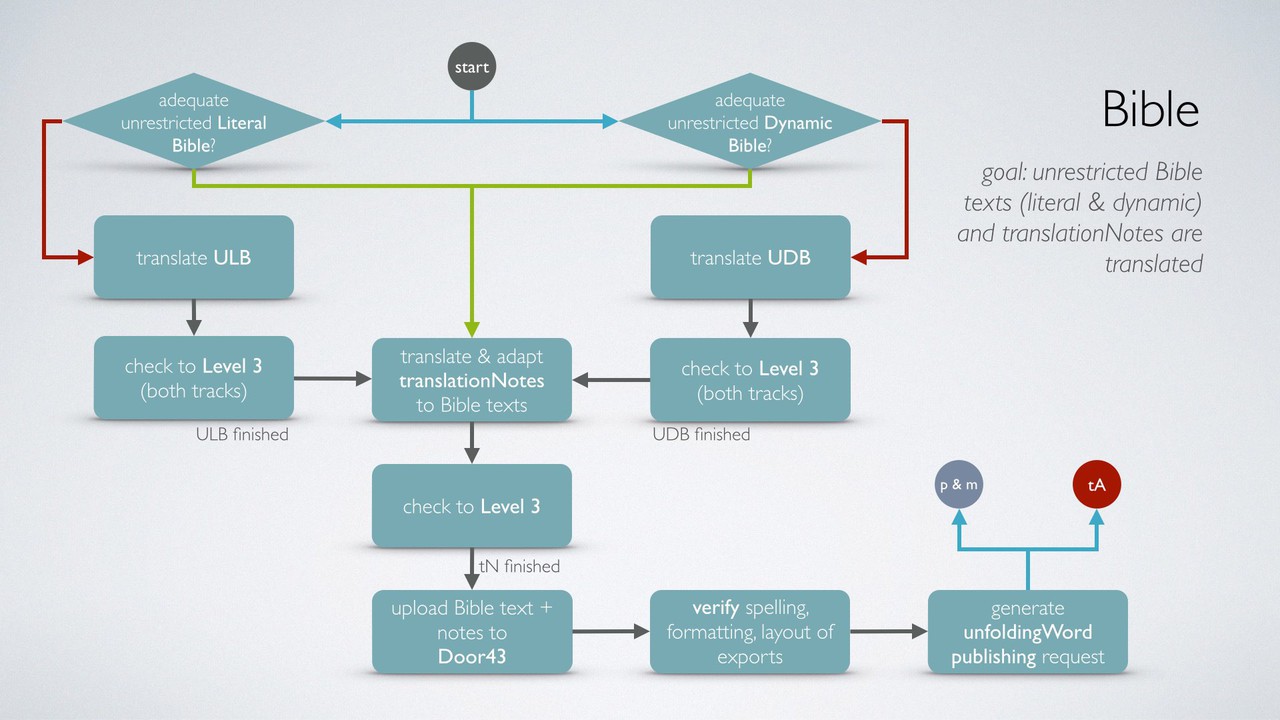
Whenever a translator is translating from a translation and does not have adequate ability with the original biblical languages, the resulting translation can tend to skew farther than it should from the original. In order to minimize this, it is better to translate from two translations concurrently: one that preserves important elements of the form of the original (i.e. a more “literal” translation) and one that clarifies the function of the original (i.e. a more “dynamic” or “meaning-based” translation).
The first step is to identify if an adequate unrestricted Literal Bible and an adequate unrestricted Dynamic Bible exists in the Gateway Language, by which is meant:
- adequate — the Bible text should be in a structured digital format (USFM or USX is ideal) and the translation itself should be of good quality, reputable, and well-regarded by the Church.
- unrestricted — the most common scenario is likely to involve identifying an older Bible translation in the public domain (though not all of them are necessarily adequate). Do not use a translation under the assumption it is in the clear—check with Translation Services first! Otherwise, a Bible translation must be procured under Creative Commons Attribution-ShareAlike 4.0.
If adequate literal and dynamic Bible translations are not available, the Unlocked Literal Bible (ULB) and Unlocked Dynamic Bible (UDB) should be translated and checked to Level 3. Then the translationNotes for each book of the Bible should be translated and adapted to the translations and then checked to Level 3. Once all the text and notes have been uploaded to Door43 and checked for formatting and spelling, an unfoldingWord publishing request should be generated.
STAGE 2 OPEN! For every book of the Bible completed to this point, the Gateway Language is now open for translation and Church-centric checking of the Bible in every language on the other side.
Print + Media
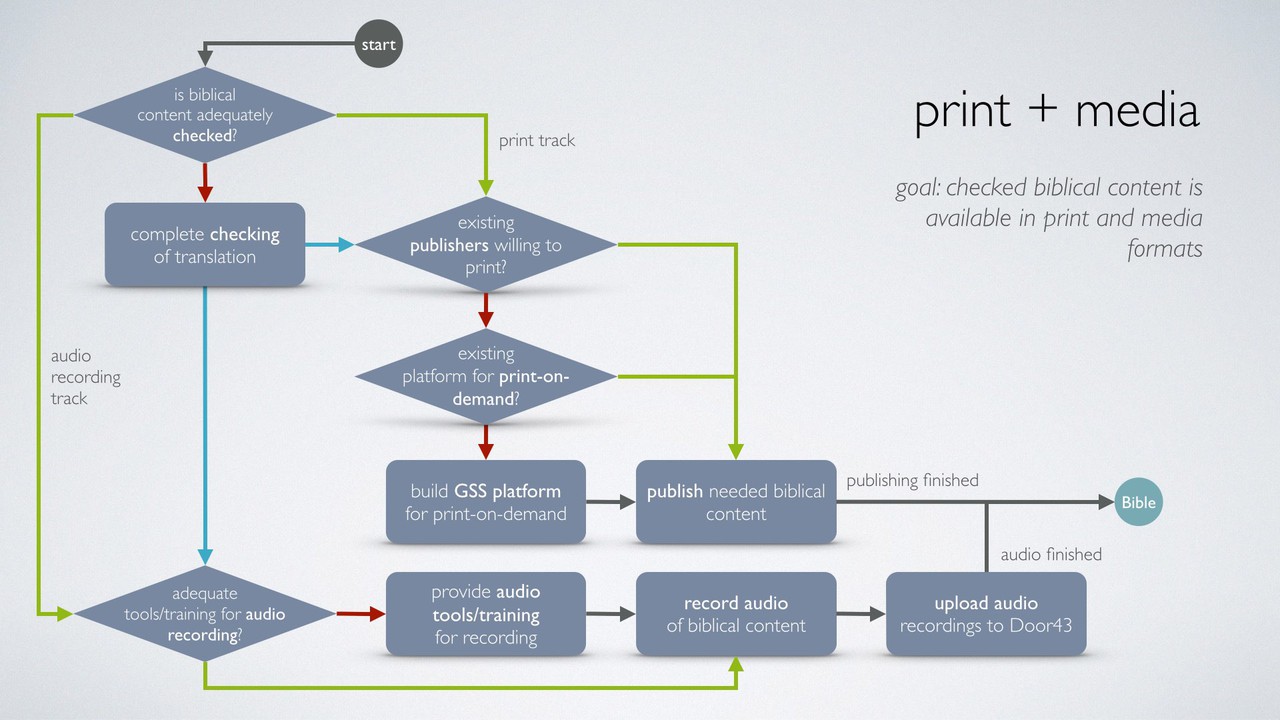
After biblical content has been adequately checked (Level 3, for Gateway Languages), the content needs to be made available in print and media formats, especially audio. If adequate tools and training for high-quality audio recording is already available to the Gateway Languages translation team, they can proceed directly to recording audio formats of the biblical content. If they do not have what they need for audio recording, this must first be provided. Once complete (and checked for adequate audio quality), the recording can be uploaded to Door43 where they will be made available in the unfoldingWord media catalog.
In the print track, the first step is to identify if existing publishers are willing to print the finished translations of the biblical content translated into the Gateway Language. If so, arrangements should be made to publish the biblical content.
If not, print-on-demand technology may provide an affordable solution. If existing print-on-demand infrastructure is in place and can meet the demand, it should be pursued as a publishing platform. If not, a print-on-demand publishing platform should be developed in order to publish the needed biblical content.
A Synthesis
